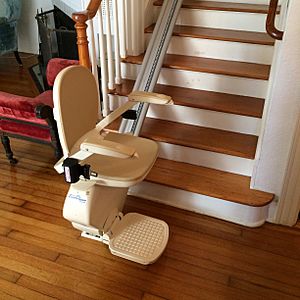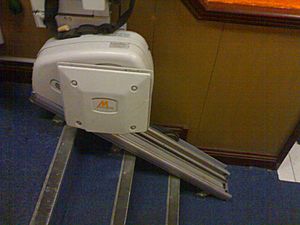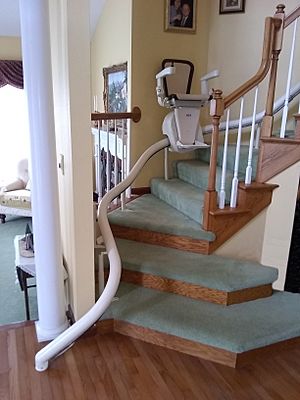Stair lift facts for kids
A stair lift is a special machine that helps people move up and down stairs. It's often used by people who find stairs difficult, like older adults or those with disabilities. Imagine a chair or a small platform that travels along a rail attached to the stairs. You sit on the chair or roll onto the platform, and it gently carries you from one floor to another.
Stair lifts are also called stairlifts, chair lifts, or stair gliders. It's important not to confuse them with the chairlifts skiers use on mountains!
The first stair lifts sold in the U.S. appeared in the 1930s. Many people who used them at that time were recovering from polio. Today, stair lifts help many people, including the elderly and those who might fall on stairs.
Contents
A Look Back: History of Stair Lifts
The idea for stair lifts is quite old! In the 1920s, a man named C.C. Crispen from Pennsylvania wanted to help a friend who had trouble moving between floors. Crispen, who taught himself engineering, designed a special seat that could climb stairs. He called his invention the "Inclin-ator."
Even before Crispen, a person named Frederick Muffett in England invented a similar "Invalid Chair with Tramway for use on Staircases."
Interestingly, a historian named David Starkey found proof in 2009 that even King Henry VIII used a type of stair lift. The king, who weighed about 190 kilograms (30 stone) and was injured from jousting, had a chair that servants pulled up and down stairs using ropes and pulleys at his palace in London.
How Stair Lifts Work
Modern stair lifts come with many helpful features. These can include seats that you can adjust, safety switches, and controls that let you call the lift to your floor. Some even have parts that fold up to save space.
The Rails
The rails are like the tracks the stair lift travels on. For straight stairs, these rails are usually made from strong metal like aluminum or steel. They are attached to the steps with metal brackets.
Sometimes, a rail might block a doorway at the bottom of the stairs. In these cases, a special hinge can be added. This allows the end of the rail to fold away when it's not being used.
For stairs that curve, the rails are custom-made to fit the exact shape of your staircase. They are designed to curve smoothly, even around tight corners. These curved rail sections are put together right at your home during installation.
The Carriages
The carriage is the part of the stair lift that moves along the rail. It usually has small wheels that help it glide smoothly. The carriage is often pulled by a cable or chain, or it might have a gear system that moves it along the rail.
Most home stair lifts have a seat with armrests and a footrest. Some special models have a platform where you can stand, called a "perch" seat. Seats can also be made shorter for people with shorter legs to make the ride more comfortable.
Typically, the seat faces sideways, at a right angle to the rail. When you reach the top of the stairs, the seat can turn, usually by 45 or 90 degrees. This makes it easy and safe to get off the lift onto the landing. You can choose a stair lift with a seat that turns by itself (powered swivel) or one you turn by hand (manual swivel).
Most seats have a safety switch. This means the stair lift won't move unless the seat is locked in the correct position for travel.
Different Kinds of Stair Lifts
Straight-Rail Stair Lifts
These are the most common type of stair lifts. They are used in homes with straight staircases. They have a simple, straight track that attaches to the steps. Straight-rail stair lifts can often be installed very quickly, sometimes within a few days. Since the rail is a standard part cut to size, they are usually the least expensive option.
Curved-Rail Stair Lifts
Curved stair lifts are built to fit staircases that have bends or turns. They offer a continuous ride up the entire staircase, even if there are flat landings in the middle. Because the rail is custom-made for each staircase, and the chair needs to stay level while turning, curved-rail stair lifts cost more than straight ones.
Designing and building a curved-rail stair lift takes careful measurements and manufacturing. The installation process usually takes longer, often several weeks. However, some companies offer curved stair lifts made from modular (pre-made) parts. These can be delivered and installed much faster, sometimes even the next day.
Wheelchair Platform Stair Lifts
These stair lifts are much stronger and larger. They are designed to carry a person while they are in a wheelchair or scooter. You'll often see them in public buildings or outside private homes.
The platform is big enough for a wheelchair. It might have ramps that fold down to help the wheelchair roll on and off easily. These ramps also act as safety barriers to keep the wheelchair from rolling off the edge. The rails for these lifts are very strong to support the heavy load.
Outdoor Stair Lifts
Outdoor stair lifts are made for stairs outside your home, like on decks or at entryways. They work just like indoor stair lifts but are built with special materials that can handle different weather conditions, from hot summers to cold winters.
Used Stair Lifts
Sometimes, you can find used stair lifts, especially the straight-rail kind. The rails can be adjusted to fit a new staircase. In the past, it was very hard to reuse curved stair lifts because each one was custom-made. However, some newer curved rails are designed in sections, making it easier to reuse parts. This can be a more affordable way to get a curved stair lift.
Goods Stair Lifts
Some stair lifts are made just for moving items, not people. They have trays instead of seats and are often used in businesses or factories to move boxes or supplies between floors.
How Stair Lifts Get Power
Older stair lifts often used regular house electricity (AC power). A cable would run along the rail to power the moving part.
Today, most home stair lifts use rechargeable batteries (DC power). A great benefit of battery-powered lifts is that they can still work during a power outage, as long as the batteries are charged. Most stair lifts have a special "charge point" where they park to recharge their batteries. Some straight stair lifts can even charge continuously no matter where they stop on the track.
The batteries are usually located inside the moving carriage itself. The motors that move the stair lift are typically not very powerful, often around 250 watts for a home straight-rail lift. Lifts for heavier loads or steeper stairs need more power.
Controlling Your Stair Lift
Stair lifts are usually controlled by a switch or lever on the armrest. These controls are designed to be easy to use, even for people with limited movement.
Many stair lifts also come with remote controls that use radio waves or infrared signals. These remotes let you call the lift to your floor or send it away.
Modern stair lifts have smart electronic controls. Curved stair lifts, for example, have more complex controls. This is because the seat might need to tilt to stay level as it goes around curves and changes angles. The lift might also slow down on bends and speed up on straight parts. These smart controls can even "learn" the path of the journey and record information, which helps service technicians if there's a problem.
Safety First
Safety is very important for stair lifts. They have special cut-off switches and "safety edges." These features automatically stop the lift if something gets in the way, like an object on the stairs. This prevents accidents and keeps everyone safe.
Many stair lifts also come with a key. This allows the user to lock the lift, preventing others (like curious children) from using it without permission.
There are strict safety rules and standards that stair lift manufacturers must follow to make sure their products are safe and reliable.
Installation
While some stair lifts can be bought for self-installation, most experts in the home medical equipment field recommend having a trained professional install them. Professionals know all the safety rules and local codes. They also ensure the warranty is valid and can provide long-term care and service for the lift, which can save money in the long run.
How Fast Do They Go?
Stair lifts usually start moving slowly and smoothly so you don't feel a sudden jerk. A typical home straight-rail stair lift travels at about 0.07 to 0.15 meters per second (about 0.34 miles per hour). Curved stair lifts might change speed during their journey, slowing down on bends and inclines.
How Much Do They Cost?
The price of a stair lift can vary a lot because each one is often customized. Basic models usually start between $3,000 and $5,000. The final cost depends on many things, such as how long the rail needs to be, if there are any curves, if you want special seat upgrades, or if you choose a powered seat swivel.
See also
 In Spanish: Salvaescaleras para niños
In Spanish: Salvaescaleras para niños





